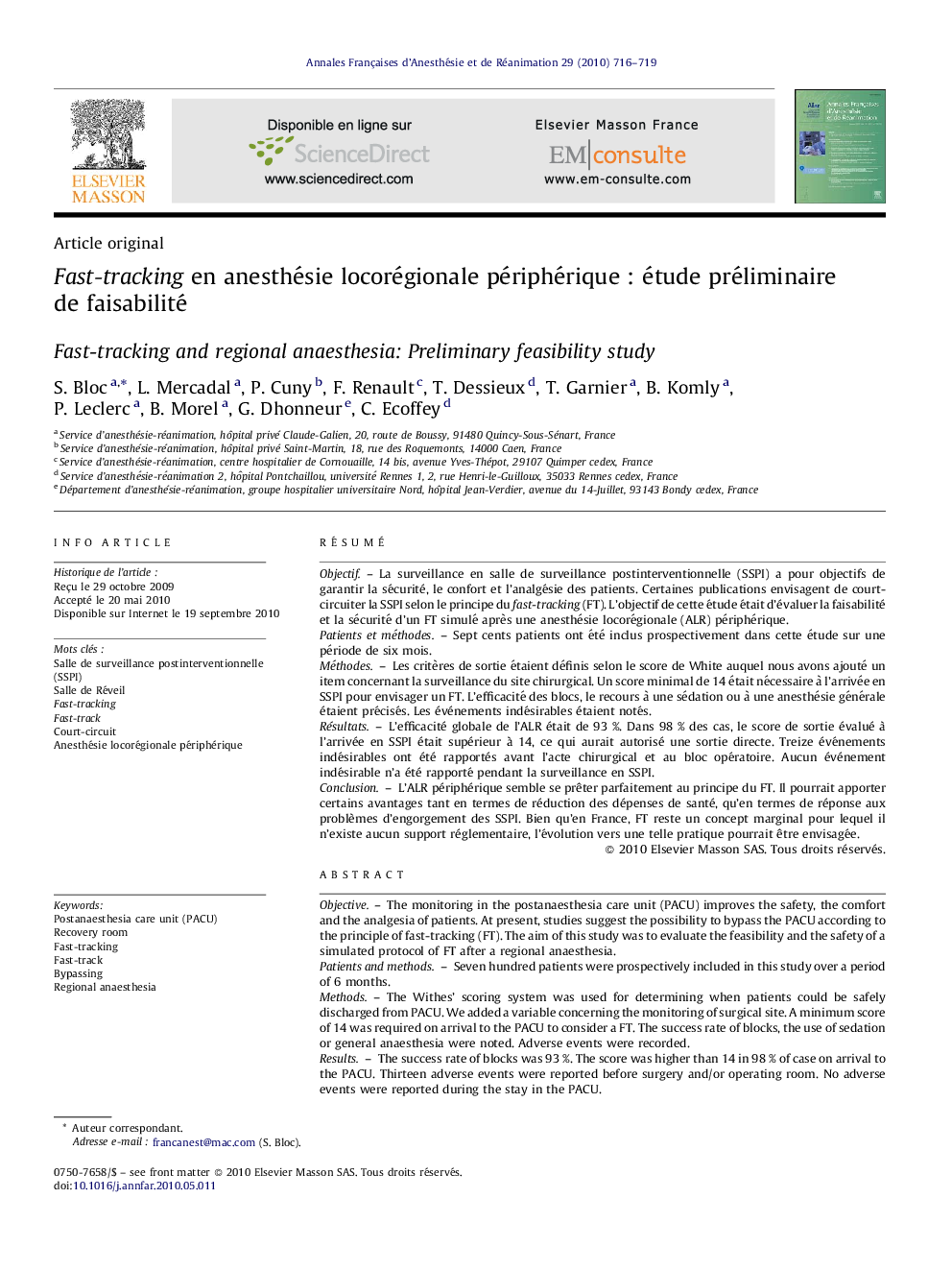| کد مقاله | کد نشریه | سال انتشار | مقاله انگلیسی | نسخه تمام متن |
|---|---|---|---|---|
| 2746492 | 1148877 | 2010 | 4 صفحه PDF | دانلود رایگان |

RésuméObjectifLa surveillance en salle de surveillance postinterventionnelle (SSPI) a pour objectifs de garantir la sécurité, le confort et l’analgésie des patients. Certaines publications envisagent de court-circuiter la SSPI selon le principe du fast-tracking (FT). L’objectif de cette étude était d’évaluer la faisabilité et la sécurité d’un FT simulé après une anesthésie locorégionale (ALR) périphérique.Patients et méthodesSept cents patients ont été inclus prospectivement dans cette étude sur une période de six mois.MéthodesLes critères de sortie étaient définis selon le score de White auquel nous avons ajouté un item concernant la surveillance du site chirurgical. Un score minimal de 14 était nécessaire à l’arrivée en SSPI pour envisager un FT. L’efficacité des blocs, le recours à une sédation ou à une anesthésie générale étaient précisés. Les événements indésirables étaient notés.RésultatsL’efficacité globale de l’ALR était de 93 %. Dans 98 % des cas, le score de sortie évalué à l’arrivée en SSPI était supérieur à 14, ce qui aurait autorisé une sortie directe. Treize événements indésirables ont été rapportés avant l’acte chirurgical et au bloc opératoire. Aucun événement indésirable n’a été rapporté pendant la surveillance en SSPI.ConclusionL’ALR périphérique semble se prêter parfaitement au principe du FT. Il pourrait apporter certains avantages tant en termes de réduction des dépenses de santé, qu’en termes de réponse aux problèmes d’engorgement des SSPI. Bien qu’en France, FT reste un concept marginal pour lequel il n’existe aucun support réglementaire, l’évolution vers une telle pratique pourrait être envisagée.
ObjectiveThe monitoring in the postanaesthesia care unit (PACU) improves the safety, the comfort and the analgesia of patients. At present, studies suggest the possibility to bypass the PACU according to the principle of fast-tracking (FT). The aim of this study was to evaluate the feasibility and the safety of a simulated protocol of FT after a regional anaesthesia.Patients and methodsSeven hundred patients were prospectively included in this study over a period of 6 months.MethodsThe Withes’ scoring system was used for determining when patients could be safely discharged from PACU. We added a variable concerning the monitoring of surgical site. A minimum score of 14 was required on arrival to the PACU to consider a FT. The success rate of blocks, the use of sedation or general anaesthesia were noted. Adverse events were recorded.ResultsThe success rate of blocks was 93 %. The score was higher than 14 in 98 % of case on arrival to the PACU. Thirteen adverse events were reported before surgery and/or operating room. No adverse events were reported during the stay in the PACU.ConclusionRegional anaesthesia seems to be an appropriate principle to fast-track the PACU. It could be a way to reduce health care costs, and can offer solution for the PACU congestion problem. In France, the fast-tracking is a marginal concept without any support regulatory. An evolution to such a practice could be considered.
Journal: Annales Françaises d'Anesthésie et de Réanimation - Volume 29, Issue 10, October 2010, Pages 716–719